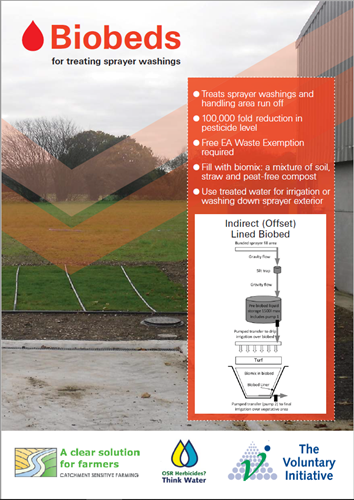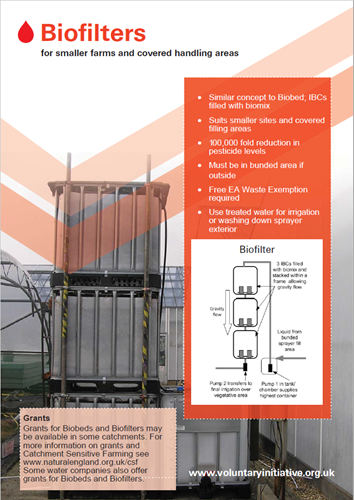BioBeds and Biofilters
Biobeds and biofilters are a proven way to deal with drips, spills and splashes that occur in sprayer handling areas. They also provide a practical convenient way to deal with sprayer washdown and sump draining.
Biobeds and biofilters, what do they do and how do they work?
Both filter out pesticides and use enhanced microbial activity to breakdown pesticides. See our leaflet to quickly learn the difference between the two (Click the following to see the difference - Biobeds and Biofilters).
They can be self-built for a modest investment. More details on installing and managing either system can be found in the Pesticide Handling Area and Bioremediation Guidance notes.
Origins
The concept of Biobeds was initially developed in Sweden in the early 1990s and has since been widely adopted with over 2000 biobeds in use there. The Swedish Biobed design was unlined and developed as a solution for accidental often unobserved splashes and spills in the pesticide handling area.
UK Researchers identified that the Biobed approach could be useful to UK farmers. It not only addresses issues in pesticide handling areas issue but also the irksome task of sprayer washdown. More research was undertaken to consider issues such as its effectiveness on a range of pesticides, the UK climate and to understand the processes better.
Research
Research has shown that Biobeds can reduce the levels of pesticides in waste water by around 100,000 fold. The research was conducted by Cranfield Research Institute, ADAS, HRI Wellesborne and Coventry University and funded by Environment Agency, Defra, SEPA and the Crop Protection Association also been supported by several crop protection companies. The research is summarised in a powerpoint presentation and the reports below.
Biobeds Research Summary Presentation
Biobeds Phase 3 Research Report
Biobeds Phase 2 Research Report
Biobeds Phase 1 Research Report
Biobeds/Biofilters
FAQ's
Before building a Biobed or Biofilter it is important to obtain a free waste exemption from the local environment agency. This can be done online.
A broadly similar approach is being taken in Scotland and Northern Ireland but detailed advice should be obtained from your local SEPA or DoENI office.
Both are regulated within the EA exemption to no more than 15,000 litres per annum of waste spray washings and washdown liquids. This does not include rainwater entering any system. It is important to try and reduce the amount of washings as far as possible to reduce the load on any system. This can be done by operating Best Practice when handling spray containers, using a portable bund or where possible having the sprayer fill area roofed over.
Biobed and Biofilter use a mixture which consists of straw (50%), soil (25%) and compost (25%) by volume and turfed over. After mixing the biobed constituent material it should be matured for approx. 3-4 weeks before placing it into the lined pit. Selecting a light, or medium, loamy soil enhances performance. Clay soils should be avoided as they can be difficult to mix and may hamper drainage. Sandy soils should also be avoided as they are too free draining and will not retain the pesticide residues adequately.
The design manual, which includes labour costs, installation of concrete and some high specification materials quotes costs of £3,500-7,000. In practice most farmers can use their own staff and equipment to adapt an existing farmyard site. Innovative and DIY approaches may result in much lower costs. A Biofilter will be much less, generally between £1,000 – £2,500.
Certain river catchment areas have been classed as Priority Catchments. Within such areas it is possible that Countryside Stewardship grants are available to support the installation of sprayer fill areas, biobeds and biofilters. Contact your local Catchment Sensitive Farming Officer for further details. See further information below.
Surplus spray solution should be avoided by accurate measurement of the treated area and careful calculation of the quantities applied. It is also sensible to plan ahead and reserve an area of crop (where there is lowest weed, pest or disease pressure) that can be potentially under-dosed or not treated. Surplus sprayed solution is always best applied to the crop provided maximum dose rates are not exceeded. Technically the lined biobed can cope with small quantities (100-200 litres depending on Biobed size) of surplus spray solution. In England and Wales surplus solution may be disposed of in this way but only as a last resort. In Scotland SEPA do not believe this acceptable.
As stated earlier the amount of contaminated liquid can be dramatically reduced where the sprayer fill area is roofed to limit rainfall influence.
Catchment Sensitive Farming (CSF) have produced a step-by-step, illustrated guide on how to build a biofilter to treat pesticides washings. This provides practical guidance on building a biofilter but does not replace the full guidance on Pesticide handling area and Bioremediation Guide published by the VI.
Advice and grants for biofilters are available through Catchment Sensitive Farming (CSF) and Countryside Stewardship to farmers in high water priority areas and through some water companies in other water safeguard zones targeted for drinking water quality improvements.
Yes, these include evaporation either as a single process or one which enhances evaporation over a similar unit to a Biobed. Both systems may be best suited to roofed sprayer fill areas where the amount of liquid produced is not subject to rainfall. Further detail can be found here.
Latest news and information about biobeds
LEAF and CSF's video on biobeds, including detailed information about their use and construction
LEAF video on Phytobac Closed System Biobed construction and management.
The 2015 Pesticide Handling Area and Biobeds Manual This incorporates EA and VI advice on Biobeds and information on Biofilters
Site Checklist This may assist in assessing the vulnerability of the sprayer fill site and prepare for further discussion
For regulatory advice visit the Environment Agency - check out biobeds, exemptions
Consultancy/design advice on Biobeds can be purchased from:
ADAS Contact Tel: 01380 859612 Charles.bentley@adas.co.uk
Bill Basford Tel: 01785 824856 Mob: 07831 141622 mechbasford@aol.com


